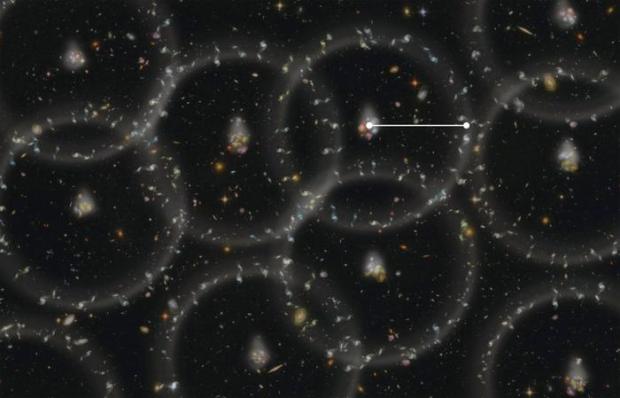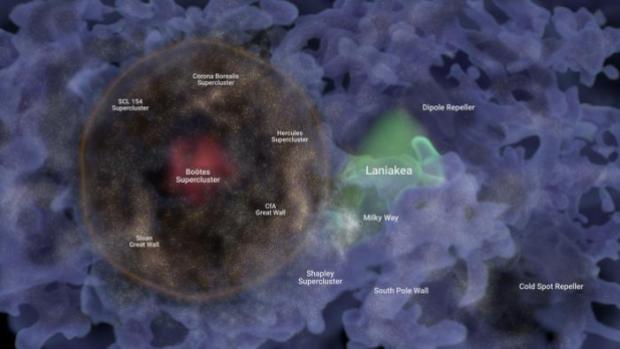
An illustration of Baryon Acoustic Oscillations, or BAO. Credit: Recreation of Baryon Acoustic Oscillations. (Zosia Rostomian, Lawrence Berkeley National Laboratory)
Astronomers recently discovered an enormous cosmic bubble packed with galaxies that stretches nearly 1 billion light-years across and seems to be an ancient vestige from the infant universe.
Named Hoʻoleilana, a nod to a Hawaiian creation chant that describes the origin of structure, the massive bubble is thought to be what’s called a baryon acoustic oscillation, or BAO. These fossilized imprints of matter in the early universe date back more than 13 billion years, to the moment the cosmos entered a new transparent phase some 380,000 years after the Big Bang.
Ho’oleilana, which is located just 820 million light-years from the Milky Way, consists of a full spherical shell of galaxies with a supercluster core, as predicted by theory. The massive bubble also displays an enhanced density of galaxies emanating from its center, and it is composed of previously identified structures that themselves are some of the largest known structures in the universe.
The new finding, published Sept. 5 in The Astrophysical Journal, will not only help astronomers untangle the mysteries of early galaxy evolution, but also might hint at subtle issues concerning the expansion rate of the universe.
How BAOs are born
Massive BAOs like Ho’oleilana are predicted based on our current understanding of the Big Bang and how the early universe evolved.
For about 400,000 years following the Big Bang, matter in the universe took the form of a dense, nearly uniform sea of extremely hot plasma, with electrons too energized to settle down with atomic nuclei. Slight density fluctuations (of roughly one part in 100,000) within this sea led to gravity attempting to pull together larger pockets of matter.
However, the universe remained too hot for particles to cling together after colliding, leading to a tug-of-war between the outward pressure of radiation and the inward pull of gravity. This created pressure oscillations similar to sound waves in the plasma sea. BAOs were created when these pressure oscillations rippled outward, leading to slight overdensities of matter.
But then, some 380,000 years after the Big Bang, the universe cooled to the point that the sea of electrons and nuclei combined into neutral atoms, making the cosmos transparent to radiation. At that point, the bubbles became frozen in place, with any matter density peaks eventually manifesting as vast bubbles that are densely populated with galaxies.
By observing and analyzing patterns in galaxy distribution within BAOs, astronomers can learn a great deal about what gave rise to the largest cosmic structures in the universe.

In the illustration the red region shows the shell enclosed by the Baryon Acoustic Oscillation, with individual galaxies depicted as luminous tiny specks. The blue filaments show the greater Cosmic Web, with previously known features like Laniākea highlighted. Credit: Frédéric Durillon, Animea Studio; Daniel Pomarède, IRFU, CEA University Paris-Saclay. This work benefited from a government funding by France 2030 (P2I – Graduate School of Physics) under reference ANR-11-IDEX-0003.Piecing together a cosmic jigsaw
The first hints of Ho’oleilana were uncovered in 2016 by the Sloan Digital Sky Survey, which captured part of its shell structure. However, that shell was never linked to a BAO, as the true extent of the billion-light-year-wide bubble remained hidden.
“We were not looking for it,” said Brent Tully, an astronomer from the University of Hawai’i and lead author of the new study, in a press release. “It is so huge that it spills to the edges of the sector of the sky that we were analyzing.”
Using data from Cosmicflows-4, the largest-ever compilation of precise galaxy distance, the researchers mapped out the gargantuan bubble in three dimensions, allowing them to discern Ho’oleilana’s full spherical shell, as well as unravel how its many galaxies are clustered together.
“Constructing this map and observing the vast shell structure was an awe-inspiring process,” said co-author Daniel Pomarede of CEA Paris-Saclay University in France, who refers to himself as the cartographer of the group.
“[M]apping Hoʻoleilana in three dimensions helps us understand its content and relationship with its surroundings,” he added. “It was an amazing process to construct this map and see how the giant shell structure of Hoʻoleilana is composed of elements that were identified in the past as being themselves some of the largest structures of the universe.”
Some of the previously identified enormous structures that are now linked to Ho’oleilana include the Sloan Great Wall, the Hercules complex, the Coma Great Wall, the Boötes Supercluster (near the core of the bubble), and the expansive Boötes Void, which is a roughly 400-million-light-year-wide spherical underdensity of galaxies.
In conflict with the Hubble constant?
The discovery of Ho’oleilana might have more profound implications than just a better understanding of the hierarchy of nearby galactic superstructures, too. According to Tully, the enormity and proximity of Hoʻoleilana raises questions about the presumed expansion rate of the universe.
“The very large diameter of one billion light years is beyond theoretical expectations,” said Tully. “If its formation and evolution are in accordance with theory, this BAO is closer than anticipated, implying a high value for the expansion rate of the universe.”
Current estimates peg the universe’s expansion rate (or Hubble constant) between 67 and 74 kilometers per second per megaparsec. But according to the new study’s analysis of Hoʻoleilana as a BAO, the researchers calculated a slightly faster expansion rate of between 74.7 and 76.9 kilometers per second per megaparsec. If confirmed, this result may further complicate the already contentious question of how fast the universe is really expanding.
The discovery of Hoʻoleilana, especially considering its vast size and proximity to the Milky Way, underscores the myriad mysteries that the cosmos still holds. However, as with all discoveries, the researchers say further observations and analysis are needed to fully grasp the true nature of this fossilized bubble from the infant universe.





